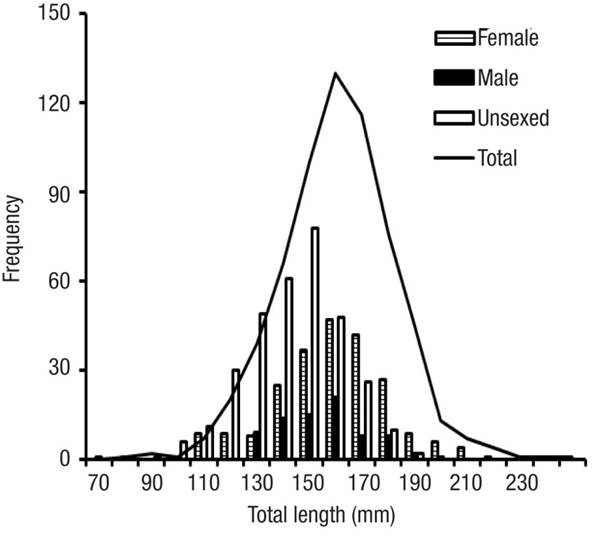The bighead mora Laemonema verecundum (Jordan & Cramer, 1897) is a relatively poorly-known species belonging to the order Gadifor mes, family Moridae. This family currently has 111 species, 17 of which belong to the genus Laemonema (Paulin, 1995). L. verecundum is an oviparous species with planktonic larvae and to date has a maximum recorded size of 11 cm (Paulin, 1995). It is mesopelagic and endemic to the Eastern Central Pacific with a distribution from 28° N to 14° N (Inada, 1995; Ambrose, 1996). Previous studies have reported the species in marine waters off Sinaloa and Jalisco, Mexico (Inada, 1995; Ambrose, 1996) and in the outer shelf and continental slope of the Gulf of California (Castro-Aguirre & Balart, 1996).
López-Martínez et al. (2012) have recently mentioned that the spe cies is relatively abundant in the Gulf of California. However, a record of bathymetric distribution had only been found in deep waters from 666 to 2600 m (Bogutskaya, 2007) where hypoxia and anoxic conditions have prevailed (Hendrickx, 2001; Allen, 2008). Until now, the presence of bighead mora had not been reported at depths less than 666 m (Ro bertson & Allen, 2002).
The specimens (N= 648) of L. verecundum were captured during two research cruises onboard the BIP XII vessel in the Gulf of California in September 2004 and February 2005 (Fig. 1). Trawls were carried out at depths of 85-251, 252-419, 420-585, and 587-752 m, with a bottom trawl net of 96.5/86.4 cm length, head rope of 38 m, mesh size of 2.54 cm, and mouth perimeter of 68 m; duration of hauls were about an hour at an average speed of 5 km per hour. Environmental variables, such as temperature and concentration of dissolved oxygen in the water co lumn, were measured at each station with a CTD. A subsample of 20 kg was taken randomly and kept frozen until subsequent processing in the laboratory. Members of the family Moridae were separated and identified to species level using keys and descriptions by Fitch & Barker (1972); Paulin (1995), and Robertson and Allen (2002). Laemonema ve recundum differs from the other members of the family in the area for having a microscopic chin; it also has a row of vomerine teeth, and the pelvic fins are reduced to two rays; the belly is without spots and devoid of scales (Inada, 1995).

Figure 1 Study area of x Laemonema verecundum during the exploration cruises in the Gulf of California, Mexico, during September 2004 and February 2005. Black points represent sampling stations.
Voucher specimens were fixed in 10% formaldehyde and were subsequently preserved in 70% ethanol (Fig. 2). The material was de posited at the fish collection of the Laboratory of Fisheries of the Centro de Investigaciones Biológicas del Noroeste, Unidad Sonora, Guaymas campus.

Figure 2 Specimen of Laemonema verecundum (12.78 cm) collected in the Gulf of California, Mexico, during September 2004 and February 2005.
Specimens of L. verecundum ranged in size from 75 to 247 mm total length (TL), with an average size of 157.5 mm TL, and a modal size of 150 mm TL. Females (N = 226) ranged in size from 100 to 240 mm TL and males (N = 80) from 70 to 200 mm TL, two folds greater than the maximum length reported by Paulin (1995); 324 specimens were immature (Fig. 3, Table 1).

Figure 3 Size frequency by sex of Laemonema verecundum during the exploration cruises in the Gulf of California, Mexico, in September 2004 and February 2005.
Table 1 Capture dates and geographical coordinates of Laemonema verecundum during the two research exploration cruises in the Gulf of Califor nia, Mexico. O2 = oxygen, T= temperature; material examined in number of organisms, and TL = total length.

Specimens of L. verecundum were collected at depths from 165 to 483 m and the greatest abundance was recorded at 280 m. Temperatu re ≤ 18° C and salinity ≤ 35.0 were recorded at these depths, which are characteristic of the subtropical subsurface water mass (Torres-Orozco, 1993). The distribution of organisms was not homogeneous bathyme trically; 60% of the total catch was at a depth range from 260 to 300 m (Fig. 4), which was lower than zero reported by Bogutskaya (2007) by a difference of 500 m. The catch area of the organisms went from 25° 40’12” N and 109°35’ 21’’ W up to 28° 09’05’’ N and 111° 18’ 10’’ W, based on nine stations where the species was present. The maximum catch was located between 27° 22’ and 27° 59’ N south of Guaymas, Sonora (Table 1). Temperature and dissolved oxygen fluctuated at these stations from 9.5 to 18.1° C, with an average of 13.1° C, and from 0.29 to 6.9 mg/l, with an average of 1.7 mg/l, respectively.

Figure 4 Organisms per hour of throws of Laemonema verecundum by depth during the exploration cruises in the Gulf of California, Mexico, in September 2004 and February 2005.
The minimum catch was obtained at greater depths where tem perature and dissolved oxygen were at a minimum level, 9.5° C and 0.29 mg/l (Table 1). The population structure of L. verecundum showed a high presence of young and adult organisms, which suggests that this species might be established in shallower waters (a still deeper continental shelf) of the Gulf. This type of distribution changes in reports of various marine species has been attributed to the effects of global climate change. However, the presence of this species in adjacent sha llower waters suggests an expansion of its distribution.
This new record of L. verecundum reveals the distribution and size of its population in shallower waters, contributing to the understanding of the biology and ecology of a relatively poorly known deep-sea spe cies of the Gulf of California.











 nova página do texto(beta)
nova página do texto(beta)


